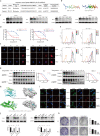High-potency PD-1/PD-L1 degradation induced by Peptide-PROTAC in human cancer cells
- PMID: 36333311
- PMCID: PMC9636179
- DOI: 10.1038/s41419-022-05375-7
High-potency PD-1/PD-L1 degradation induced by Peptide-PROTAC in human cancer cells
Conflict of interest statement
The authors declare no competing interests.
Figures

Similar articles
-
A cyclic peptide-based PROTAC induces intracellular degradation of palmitoyltransferase and potently decreases PD-L1 expression in human cervical cancer cells.Front Immunol. 2023 Oct 2;14:1237964. doi: 10.3389/fimmu.2023.1237964. eCollection 2023. Front Immunol. 2023. PMID: 37849747 Free PMC article.
-
Effect of the hairpin structure of peptide inhibitors on the blockade of PD-1/PD-L1 axis.Biochem Biophys Res Commun. 2020 Jun 25;527(2):453-457. doi: 10.1016/j.bbrc.2020.04.018. Epub 2020 Apr 23. Biochem Biophys Res Commun. 2020. PMID: 32336542
-
Design, synthesis and evaluation of PD-L1 peptide antagonists as new anticancer agents for immunotherapy.Bioorg Med Chem. 2021 Jan 15;30:115951. doi: 10.1016/j.bmc.2020.115951. Epub 2020 Dec 15. Bioorg Med Chem. 2021. PMID: 33360579
-
Emerging Role of Ubiquitination in the Regulation of PD-1/PD-L1 in Cancer Immunotherapy.Mol Ther. 2021 Mar 3;29(3):908-919. doi: 10.1016/j.ymthe.2020.12.032. Epub 2021 Jan 1. Mol Ther. 2021. PMID: 33388422 Free PMC article. Review.
-
Beyond T Cells: Understanding the Role of PD-1/PD-L1 in Tumor-Associated Macrophages.J Immunol Res. 2019 Nov 4;2019:1919082. doi: 10.1155/2019/1919082. eCollection 2019. J Immunol Res. 2019. PMID: 31781673 Free PMC article. Review.
Cited by
-
Targeted Protein Degradation (TPD) for Immunotherapy: Understanding Proteolysis Targeting Chimera-Driven Ubiquitin-Proteasome Interactions.Bioconjug Chem. 2024 Aug 21;35(8):1089-1115. doi: 10.1021/acs.bioconjchem.4c00253. Epub 2024 Jul 11. Bioconjug Chem. 2024. PMID: 38990186 Free PMC article. Review.
-
A review of lactate-lactylation in malignancy: its potential in immunotherapy.Front Immunol. 2024 May 8;15:1384948. doi: 10.3389/fimmu.2024.1384948. eCollection 2024. Front Immunol. 2024. PMID: 38779665 Free PMC article. Review.
-
How to target membrane proteins for degradation: Bringing GPCRs into the TPD fold.J Biol Chem. 2024 Dec;300(12):107926. doi: 10.1016/j.jbc.2024.107926. Epub 2024 Oct 23. J Biol Chem. 2024. PMID: 39454955 Free PMC article. Review.
-
Peptide based vesicles for cancer immunotherapy: design, construction and applications.Front Immunol. 2025 May 27;16:1609162. doi: 10.3389/fimmu.2025.1609162. eCollection 2025. Front Immunol. 2025. PMID: 40496863 Free PMC article. Review.
-
A cyclic peptide-based PROTAC induces intracellular degradation of palmitoyltransferase and potently decreases PD-L1 expression in human cervical cancer cells.Front Immunol. 2023 Oct 2;14:1237964. doi: 10.3389/fimmu.2023.1237964. eCollection 2023. Front Immunol. 2023. PMID: 37849747 Free PMC article.
References
-
- Yao H, Lan J, Li C, Shi H, Brosseau JP, Wang H, et al. Inhibiting PD-L1 palmitoylation enhances T-cell immune responses against tumours. Nat Biomed Eng. 2019;3:306–17. - PubMed
Publication types
MeSH terms
Substances
LinkOut - more resources
Full Text Sources
Other Literature Sources
Medical
Research Materials

